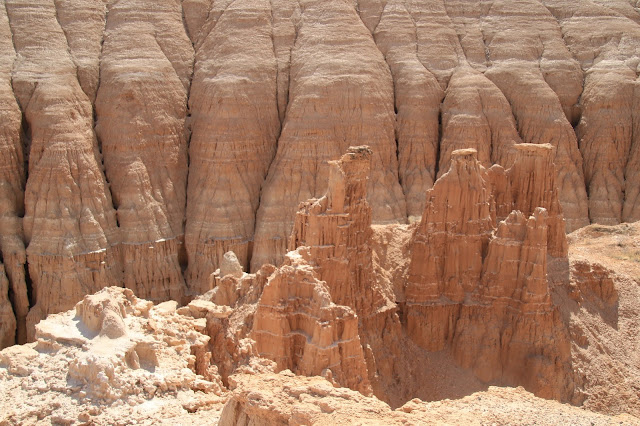April 23 - 25, 2018:
We had a beautiful ride today on routes 15, 168 and 93. It was especially scenic on route 168 and 93. We actually had route 168 all to ourselves, I don’t recall passing another vehicle for thirty some miles. Route 93 passed through the lush green, fertile Pahranagat valley and lakes surrounded by mountain ranges on both sides. It was a ribbon of green sandwiched by arid desert terrain. There were lakes, swampy areas, a large wildlife preserve, several farm and ranch lands and the quaint towns of Ash Springs and Alamo. We then climbed uphill through a forest of Joshua Trees and then over the Oak Springs Summit. I even passed what appeared to be three wild horses on the road way.
 |
| The green Pahranagat Valley |
 |
| Wild Horses on the road |
Twinkles drove the Jeep today and arrived at Cathedral Gorge State Park ahead of me to claim a campsite. It is a first come-first served campground with nice roomy sites with canopy covered picnic tables, a fire pit, a shower house and optional electric. This is unusual in that all sites have a power box, if you elect to use it you pay an extra $10 a day, if not you pay the standard $15 a day.
 |
| The campsite |
Cathedral Gorge State Park is amazing, the rock shapes and spires truly look like cathedrals and the mudstone slot canyons are like something out of this world. It seems you can wander into any of these slot canyons, no warning signs and none are closed off. Most are short, but we were in a couple that went quite far with branches and caves. It might not be a good place for you if you suffer from claustrophobia or if you worry about the tons of rock above you that potentially could fall. Erosion has created a artistic masterpiece here !
 |
| It's an amazing view ! |
 |
I think of melted candles as I look at how
these old lake sediment deposits have eroded
|
There was once a small town of Bullionville where a smelter was located next to the State Park. A small graveyard is about all that remains today, there is a short trail to it, a few gravestones are there, but most graves are unmarked.
 |
This is one of the few markers, but it is touching to read as
each side notes the death of a young family member
|
A few other noteworthy trail photos and views at the State Park.
 |
Looking down into the valley
|
 |
| A very pointed peak |
 |
This spire is almost worn away
|
I did a solo adventure to the nearby interesting towns of Panaca, Pioche and Caliente.
Panaca is adjacent to the State Park and is a small farming community with green irrigated fields and range land. It is the oldest town in southern Nevada settled in 1864 by Mormon pioneers. It is also the only dry community in Nevada. There isn’t much to see in downtown of interest except for a few old stone houses and an impressive Lincoln County school complex.
https://en.wikipedia.org/wiki/Panaca,_Nevada
 |
The founders, devout Mormons
|
 |
I thought the Spud Shop was interesting, I was wondering
what Spudnuts were ? |
Pioche became the largest mining town in southeastern Nevada with 10,000 people in 1871. It all started in 1864 when William Hamblin, a Latter Day Saint Missionary, was led to Silver deposits by a native Paiute Indian. In 1868 San Francisco financier Francois Pioche purchased the claims, built a smelter and started the Meadow Valley Mining Company. Due to its remote location, it was lawless and one of the toughest towns in the west. Hired gunmen were hired at a rate of 20 per day during the boom times to fight mining claim encroachments. This town has lots of potential, but they are not doing much to attract anyone. I went to the Pioche Museum which had some great stuff on display.
 |
This was part of a cable car that moved ore down to the smelter
|
 |
Almost across the street was this open mine pit surrounded
by only a barbed wire fence |
 |
Old store on Main Street
|
 |
The Overland Hotel appears to be doing well
|
 |
The GEM Theater is for sale, needs a savior
|
 |
As I took this photo a man came by and started a conversation.
He was 80 and told me he was married in this Lodge building.
It was built in 1873, one of the oldest in Nevada. |
 |
Interesting old photos and advertisements on this
store front |
 |
A line of organs from town that were saved, restored
and donated by a local man
|
 |
| The Court House |
 |
| Old hotel next to the Court House, in rough condition |
Caliente was founded as the Culverwell Ranch in 1901 and named for the hot springs found there. In 1905 the Union Pacific Railroad was completed through Caliente which became a train yard creating much business and employment for the town. It remains a vibrant rail line today, but these days there is no maintenance shop or yard. It has a wonderful Spanish mission Train Depot, built in 1923, with lots of potential, but it's in rough condition, needing paint and exterior work badly. The "Boxcar Museum" is located adjacent to the Depot, but there isn't much on display. Caliente look pretty poor and run down, I wasn't impressed.
https://en.wikipedia.org/wiki/Caliente,_Nevada
 |
Boxcar Museum
|
 |
Photos on display
|
 |
Old town views
|
 |
The Caliente Depot
|
 |
The old downtown area, pretty run down looking these days
|
 |
| It looks pretty, but needs a lot of help |
Next stop is Panguitch, Utah;
Twinkles and Slick


































































